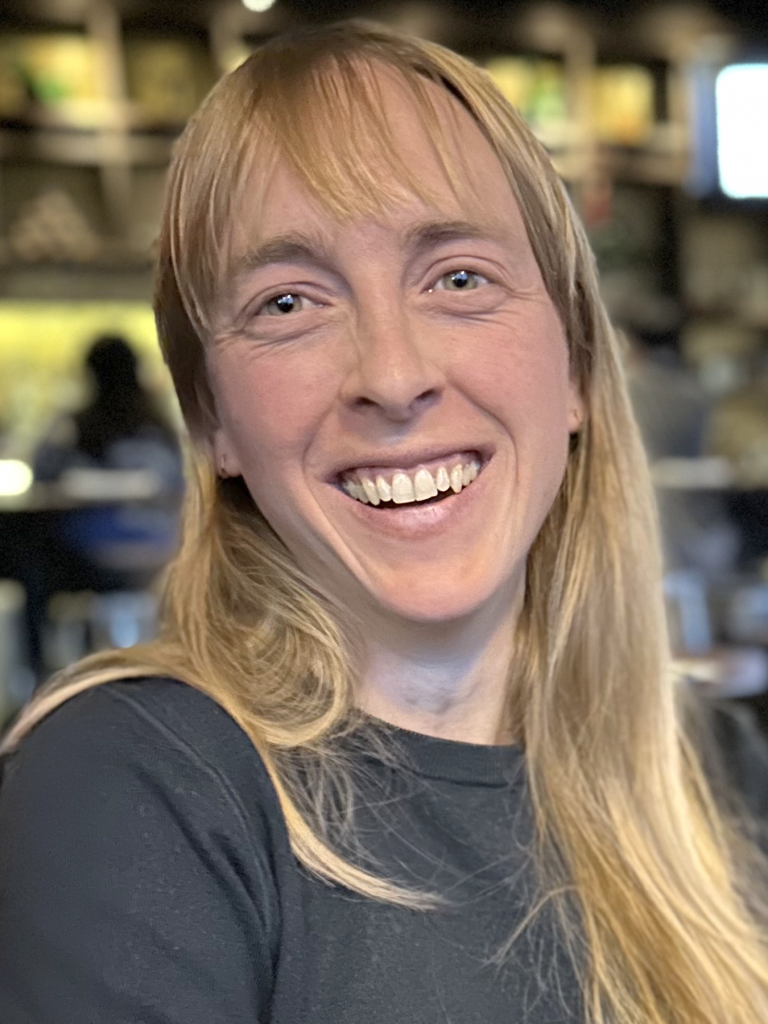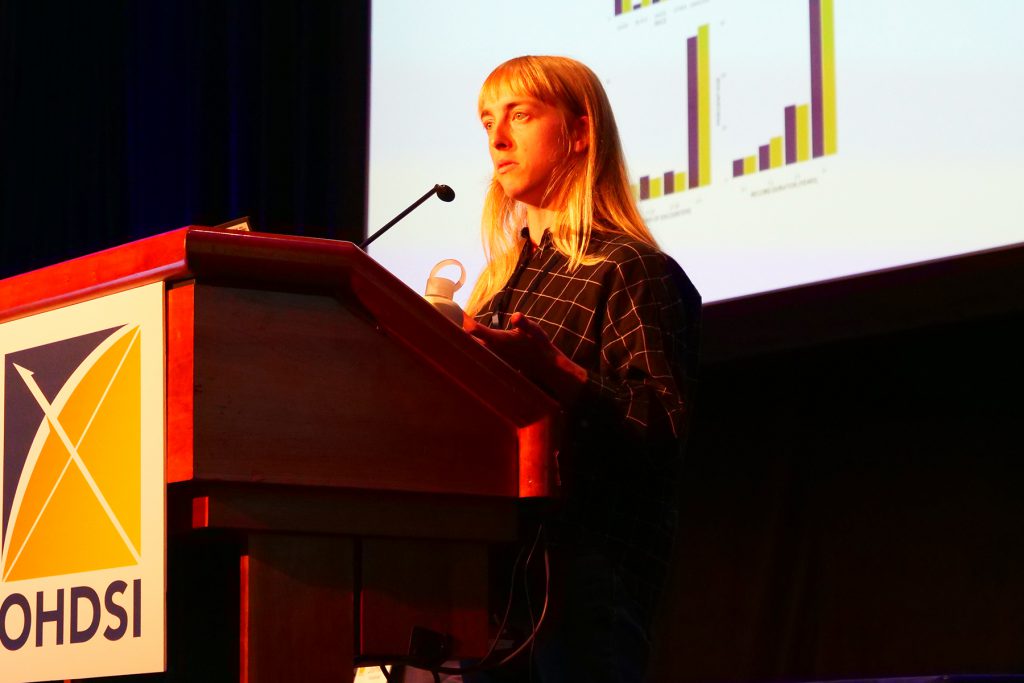- Who We Are
- Updates & News
- Standards
- Software Tools
- Network Studies
- Community Forums
- Education
- New To OHDSI?
- Community Calls
- Past Events
- Workgroups
- 2024 ‘Our Journey’ Annual Report
- Current OHDSI Events
- Support & Sponsorship
- CBER Best Seminars
- 2024 Global Symposium
- Guideline Opportunities
- Github
- YouTube
- Newsletters
Collaborator Spotlight: Alison Callahan
Alison Callahan is an Instructor in the Center for Biomedical Informatics and Clinical Data Scientist in the Stanford Health Care Data Science Team. Her current research uses informatics to extract perinatal health data from electronic health records, and to study medication usage and effectiveness in pregnancy. She is also the co-leader of the OHDSI Perinatal & Reproductive Health (PRHeG) working group. Her work in the SHC Data Science team focuses on developing and implementing methods to assess and identify high value applications of machine learning in healthcare settings.
Alison completed her PhD in the Department of Biology at Carleton University in Ottawa, Canada. Her doctoral research focused on developing HyQue, a framework for representing and evaluating scientific hypotheses, and applying this framework to discover genes related to aging. She was also a developer for Bio2RDF, an open-source project to build and provide the largest network of Linked Data for the life sciences. Her postdoctoral work at Stanford applied methodologies developed during her PhD to study spinal cord injury in model organisms and humans in a collaboration with scientists at the University of Miami.
Alison discusses her career journey, how OHDSI impacts her research at Stanford, critical knowledge gaps that can be addressed by the Perinatal and Reproductive Health workgroup, and more in the latest edition of the Collaborator Spotlight.

Can you discuss your career journey, and what your current role at Stanford is?
When I started my undergraduate studies in Ontario, Canada (where I grew up), my original goal was to become a librarian! I had researched graduate degrees in library science, and my plan was to get a Bachelor of Science at whichever university accepted me, and then apply to the library science graduate program at the University of Toronto. That plan was successful, and in 2009 I graduated from U of T with a Masters of Information Studies (where I had also worked part time in the science library). Onwards to librarianship, right?! Not so fast – I had taken bioinformatics classes during my undergrad, and found them both very challenging (I had no computer science or coding experience) and extremely interesting. So, when I finished my masters degree and had the opportunity to continue studying bioinformatics as a doctoral student in the Biology Department at Carleton University, I went for it, and I graduated with a PhD in Biology in 2014. It was through my doctoral research that I connected with Dr. Nigam Shah, and headed to Stanford for postdoctoral studies in his lab. This was the start of my career doing medical informatics research. I’ve been at Stanford since, first as a Postdoctoral Scholar, then Research Scientist, and now Instructor and Clinical Data Scientist. I split my time between doing research and teaching in the School of Medicine, and working as part of the Data Science Team at Stanford Health Care developing methods to evaluate the usefulness and feasibility of machine learning applications in healthcare settings.
How did you first become acquainted with the OHDSI community, and what drew you to remain involved?
I become part of the OHDSI community through my work in Nigam’s lab – we were early adopters of the OMOP CDM and OHDSI statistical tools starting in 2015, and we also contributed to the initial design of CDM tables that capture information about clinical notes and their content. Seeing the power of OHDSI network studies across multiple data sources and health systems, having the opportunity to contribute to the design of reproducible research methods, and the many amazing people I’ve met through this community, have kept me coming back.
You have been around OHDSI for several years, so what are some recent developments within the community that you have found most beneficial to your own research goals?
The evolution of OHDSI infrastructure for collaboratively developing and sharing phenotypes has been crucial to the lab’s participation in the 20+ network studies we’ve contributed to, and to the studies we’re planning to develop as part of the Perinatal and Reproductive Health Workgroup (more on that below!).

Alison Callahan provided a talk on “Delivering on-demand evidence via an informatics consult service” at the 2019 OHDSI Symposium.
Can you provide a couple examples of how OHDSI has been integrated with the work being done at Stanford?
The Stanford Medicine Research Technology group does incredible work to maintain STARR, our clinical data warehouse that uses the OMOP CDM to provide EHR data from Stanford Health Care and Stanford Children’s Health, updated weekly and linked to imaging and monitoring data, to all investigators in Stanford Medicine. In this way, OHDSI is integral to the research data infrastructure at Stanford Medicine.
OHDSI statistical analysis tools have also been key components of research in the Shah Lab, from student projects presented at AMIA to the Green Button Informatics Consult service that answered clinician questions that arose in the course of patient care at Stanford.
You recently helped co-found the Perinatal and Reproductive Health workgroup. What are the evidence gaps in this area that you are hoping this workgroup and the OHDSI community can help inform?
I co-founded the PRHeG workgroup (with Stephanie Leonard, Assistant Professor in the Department of Obstetrics & Gynecology at Stanford University, and Louisa Smith, Assistant Professor in the Roux Institute at Northeastern University) when I realized that EHR data could help to fill key evidence gaps in perinatal and reproductive health research, including medication safety and effectiveness during pregnancy. Nine out of ten pregnant people in the United States take at least one medication! And yet, randomized trials of medication safety and effectiveness in pregnancy are rare, and observational studies either have small, selective patient populations or rely on administrative claims databases which we know are powerful due to their large size, but often are missing key information for characterizing pregnancy risk factors and outcomes such as vital signs, laboratory test results, pregnancy loss, and breastfeeding status. Antihypertensive medication use and effectiveness during pregnancy has been our initial research focus, but the more we meet as a group, the more questions and potential research projects arise.
What are the biggest challenges to starting a new workgroup, and now that you are past some of them, what are the most immediate goals for this team entering 2024?
The biggest challenges when we started PRHeG were reaching the right people to join the group (there are many in the OHDSI community doing perinatal and reproductive health research already, and it’s been key to build on this expertise), and ensuring that each workgroup meeting was time well spent for the dozens of people who have generously volunteered their time. We worked hard to strike a balance between providing a top-down structure by planning meeting agendas several months in advance, organizing invited talks by members, and having follow-up action items from each meeting, and having that structure act as a scaffold to support new research ideas from PHReG members as we have grown. Now that we have a consistent quorum of 15-20 people and some new faces at each monthly meeting, our new challenge is evolving this scaffold to support workgroup members in contributing to projects individually and in smaller teams. We are currently focused on improving perinatal data capture in the CDM through collaborations across US and Europe OHDSI sites, and across workgroups including PRHeG and the CDM workgroup. At our inaugural in-person meeting at the 2023 OHDSI Symposium, we also began creating new phenotypes specific to perinatal and reproductive health research, including pregnancy characteristics, postpartum outcomes, and neonatal outcomes. We’re excited to advance both of these efforts in 2024.
What are some of your hobbies, and what is one interesting thing that most community members might not know about you?
My love of books extends beyond my librarian education – in my non-research time, I have also trained and worked as a bookbinder, and ran a small business during my graduate studies, making journals for art and writing. Now I make them for fun 🙂
I also have two corgis, Angus and Ulla, who have joined the occasional OHDSI Teams call!
